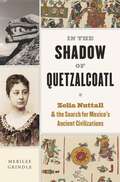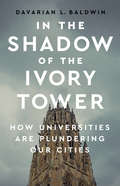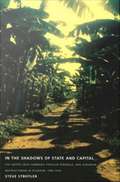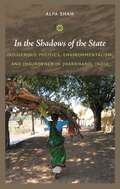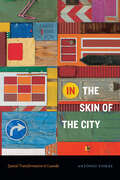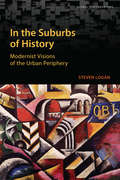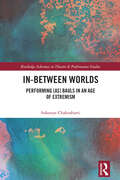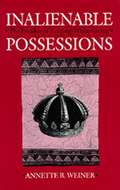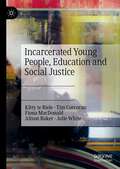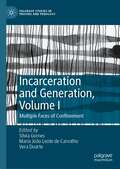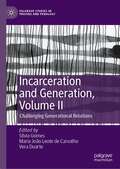- Table View
- List View
In the Shadow Of the Poorhouse: A Social History Of Welfare In America, Tenth Anniversary Edition
by Michael B. KatzWith welfare reform a burning political issue, this special anniversary edition of the classic history of welfare in America has been revised and updated to include the latest bipartisan debates on how to "end welfare as we know it. ”In the Shadow of the Poorhouse examines the origins of social welfare, both public and private, from the days of the colonial poorhouse through the current tragedy of the homeless. The book explains why such a highly criticized system persists. Katz explores the relationship between welfare and municipal reform; the role of welfare capitalism, eugenics, and social insurance in the reorganization of the labor market; the critical connection between poverty and politics in the rise of the New Deal welfare state; and how the War on Poverty of the ’60s became the war on welfare of the ’80s.
In the Shadow of Quetzalcoatl: Zelia Nuttall and the Search for Mexico’s Ancient Civilizations
by Merilee Grindle"What a woman! And what a fabulous life to unearth. Zelia Nuttall was incredibly smart, determined, a divorced single mother in a man’s world, a great scholar, and an original thinker—yet today she’s completely forgotten. Merilee Grindle has dug deep into the archives and uncovered her fascinating story."—Andrea Wulf, author of The Invention of Nature"Zelia Nuttall comes alive in all her fascinating contradictions in Merilee Grindle’s capable hands...[This] biography challenges our modern smugness and reminds us that our roots as scholars are more complex than we often acknowledge."—Camilla Townsend, author of Fifth Sun: A New History of the AztecsThe gripping story of a pioneering anthropologist whose exploration of Aztec cosmology, rediscovery of ancient texts, and passion for collecting helped shape our understanding of pre-Columbian Mexico.Where do human societies come from? The drive to answer this question took on a new urgency in the nineteenth century, when a generation of archaeologists began to look beyond the bible for the origins of different cultures and civilizations. A child of the San Francisco Gold Rush whose mother was born in Mexico City, Zelia Nuttall threw herself into the study of Aztec customs and cosmology, eager to use the tools of the emerging science of anthropology to prove that modern Mexico was built over the ruins of ancient civilizations.Proud, disciplined, as prickly as she was independent, Zelia Nuttall was the first person to accurately decode the Aztec calendar stone. An intrepid researcher, she found pre-Columbian texts lost in European archives and was skilled at making sense of their pictographic histories. Her work on the terra-cotta heads of Teotihuacán captured the attention of Frederic Putnam, who offered her a job at Harvard’s Peabody Museum.Divorced and juggling motherhood and career, Nuttall chose to follow her own star, publishing her discoveries and collecting artifacts for US museums to make ends meet. From her beloved Casa Alvarado in Coyoacán, she became a vital bridge between Mexican and US anthropologists, connecting them against the backdrop of war and revolution.The first biography of Zelia Nuttall, In the Shadow of Quetzalcoatl captures the appeal and contradictions that riddled the life of this trailblazing woman, who contributed so much to the new field of anthropology until a newly professionalized generation overshadowed her remarkable achievements and she became, in the end, an artifact in her own museum.
In the Shadow of Slavery: African Americans in New York City, 1626-1863 (Historical Studies of Urban America)
by Leslie M. HarrisA new edition of a classic work revealing the little-known history of African Americans in New York City before Emancipation. The popular understanding of the history of slavery in America almost entirely ignores the institution’s extensive reach in the North. But the cities of the North were built by—and became the home of—tens of thousands of enslaved African Americans, many of whom would continue to live there as free people after Emancipation. In the Shadow of Slavery reveals the history of African Americans in the nation’s largest metropolis, New York City. Leslie M. Harris draws on travel accounts, autobiographies, newspapers, literature, and organizational records to extend prior studies of racial discrimination. She traces the undeniable impact of African Americans on class distinctions, politics, and community formation by offering vivid portraits of the lives and aspirations of countless black New Yorkers. This new edition includes an afterword by the author addressing subsequent research and the ongoing arguments over how slavery and its legacy should be taught, memorialized, and acknowledged by governments.
In the Shadow of Slavery: African Americans in New York City, 1626–1863 (Historical Studies Of Urban America Ser.)
by Leslie M. HarrisA new edition of a classic work revealing the little-known history of African Americans in New York City before Emancipation. The popular understanding of the history of slavery in America almost entirely ignores the institution’s extensive reach in the North. But the cities of the North were built by—and became the home of—tens of thousands of enslaved African Americans, many of whom would continue to live there as free people after Emancipation.In the Shadow of Slavery reveals the history of African Americans in the nation’s largest metropolis, New York City. Leslie M. Harris draws on travel accounts, autobiographies, newspapers, literature, and organizational records to extend prior studies of racial discrimination. She traces the undeniable impact of African Americans on class distinctions, politics, and community formation by offering vivid portraits of the lives and aspirations of countless black New Yorkers. This new edition includes an afterword by the author addressing subsequent research and the ongoing arguments over how slavery and its legacy should be taught, memorialized, and acknowledged by governments.
In the Shadow of the Fallen Towers: The Seconds, Minutes, Hours, Days, Weeks, Months, and Years after the 9/11 Attacks
by Don BrownExcellence in Nonfiction for Young Adults FinalistA graphic novel chronicling the immediate aftermath and rippling effects of one of the most impactful days in modern history: September 11, 2001. From the Sibert Honor– and YALSA Award–winning creator behind The Unwanted and Drowned City. The consequences of the terrorist attack on the World Trade Center in New York City, both political and personal, were vast, and continue to reverberate today. Don Brown brings his journalistic eye and attention to moving individual stories to help teens contextualize what they already know about the day, as well as broaden their understanding of the chain of events that occurred in the attack’s wake.Profound, troubling, and deeply moving, In the Shadow of the Fallen Towers bears witness to our history—and the ways it shapes our future.
In the Shadow of the Ivory Tower: How Universities Are Plundering Our Cities
by Davarian L BaldwinAcross America, universities have become big businesses—and our cities their company towns. But there is a cost to those who live in their shadow. Urban universities play an outsized role in America&’s cities. They bring diverse ideas and people together and they generate new innovations. But they also gentrify neighborhoods and exacerbate housing inequality in an effort to enrich their campuses and attract students. They maintain private police forces that target the Black and Latinx neighborhoods nearby. They become the primary employers, dictating labor practices and suppressing wages. In the Shadow of the Ivory Tower takes readers from Hartford to Chicago and from Phoenix to Manhattan, revealing the increasingly parasitic relationship between universities and our cities. Through eye-opening conversations with city leaders, low-wage workers tending to students&’ needs, and local activists fighting encroachment, scholar Davarian L. Baldwin makes clear who benefits from unchecked university power—and who is made vulnerable. In the Shadow of the Ivory Tower is a wake-up call to the reality that higher education is no longer the ubiquitous public good it was once thought to be. But as Baldwin shows, there is an alternative vision for urban life, one that necessitates a more equitable relationship between our cities and our universities.
In the Shadow of the Seawall: Coastal Injustice and the Dilemma of Placekeeping
by Summer GrayIn the Shadow of the Seawall journeys to the low-lying lands of Guyana and the Maldives to grapple with the existential dilemma of seawalls alongside struggles to resist displacement. With the gathering momentum of ocean instability wrought by centuries of injustice, seawalls have become objects of conflict and negotiation, around which human struggles for power and resistance collide. Through stories of colonial ruination and green seawalls, the concept of placekeeping emerges—a justice-oriented framework for addressing adaptation and the global dangers of coastal disruption at the front lines of climate change. Drawing on ethnographic observation and interviews, Gray shows how seawalls are entrenched in relationships of power and entangled in processes of making and keeping place.
In the Shadows of State and Capital: The United Fruit Company, Popular Struggle, and Agrarian Restructuring in Ecuador, 1900-1995
by Steve StrifflerWinner of the 2001 President's Award of the Social Science History Association In the Shadows of State and Capital tells the story of how Ecuadorian peasants gained, and then lost, control of the banana industry. Providing an ethnographic history of the emergence of subcontracting within Latin American agriculture and of the central role played by class conflict in this process, Steve Striffler looks at the quintessential form of twentieth-century U. S. imperialism in the region--the banana industry and, in particular, the United Fruit Company (Chiquita). He argues that, even within this highly stratified industry, popular struggle has contributed greatly to processes of capitalist transformation and historical change. Striffler traces the entrance of United Fruit into Ecuador during the 1930s, its worker-induced departure in the 1960s, the troubled process through which contract farming emerged during the last half of the twentieth century, and the continuing struggles of those involved. To explore the influence of both peasant activism and state power on the withdrawal of multinational corporations from banana production, Striffler draws on state and popular archives, United Fruit documents, and extensive oral testimony from workers, peasants, political activists, plantation owners, United Fruit administrators, and state bureaucrats. Through an innovative melding of history and anthropology, he demonstrates that, although peasant-workers helped dismantle the foreign-owned plantation, they were unable to determine the broad contours through which the subsequent system of production--contract farming--emerged and transformed agrarian landscapes throughout Latin America. By revealing the banana industry's impact on processes of state formation in Latin America, In the Shadows of State and Capital will interest historians, anthropologists, and political scientists, as well as scholars of globalization and agrarian studies.
In the Shadows of the State: Indigenous Politics, Environmentalism, and Insurgency in Jharkhand, India
by Alpa ShahIn the Shadows of the State suggests that well-meaning indigenous rights and development claims and interventions may misrepresent and hurt the very people they intend to help. It is a powerful critique based on extensive ethnographic research in Jharkhand, a state in eastern India officially created in 2000. While the realization of an independent Jharkhand was the culmination of many years of local, regional, and transnational activism for the rights of the region's culturally autonomous indigenous people, Alpa Shah argues that the activism unintentionally further marginalized the region's poorest people. Drawing on a decade of ethnographic research in Jharkhand, she follows the everyday lives of some of the poorest villagers as they chase away protected wild elephants, try to cut down the forests they allegedly live in harmony with, maintain a healthy skepticism about the revival of the indigenous governance system, and seek to avoid the initial spread of an armed revolution of Maoist guerrillas who claim to represent them. Juxtaposing these experiences with the accounts of the village elites and the rhetoric of the urban indigenous-rights activists, Shah reveals a class dimension to the indigenous-rights movement, one easily lost in the cultural-based identity politics that the movement produces. In the Shadows of the State brings together ethnographic and theoretical analyses to show that the local use of global discourses of indigeneity often reinforces a class system that harms the poorest people.
In the Skin of the City: Spatial Transformation in Luanda (Theory in Forms)
by António TomásWith In the Skin of the City, António Tomás traces the history and transformation of Luanda, Angola, the nation’s capital as well as one of the oldest settlements founded by the European colonial powers in the Southern Hemisphere. Drawing on ethnographic and archival research alongside his own experiences growing up in Luanda, Tomás shows how the city’s physical and social boundaries—its skin—constitute porous and shifting interfaces between center and margins, settler and Native, enslaver and enslaved, formal and informal, and the powerful and the powerless. He focuses on Luanda’s “asphalt frontier”—the (colonial) line between the planned urban center and the ad hoc shantytowns that surround it—and the ways squatters are central to Luanda’s historical urban process. In their relationship with the state and their struggle to gain rights to the city, squatters embody the process of negotiating Luanda’s divisions and the sociopolitical forces that shape them. By illustrating how Luanda emerges out of the continual redefinition of its skin, Tomás offers new ways to understand the logic of urbanization in cities across the global South.
In the Suburbs of History: Modernist Visions of the Urban Periphery (Global Suburbanisms)
by Steven LoganIn the 1960s, socialist and capitalist urban planners, architects, and city officials chose the urban periphery as the site to test out new ideas in modernist architecture and planning: the outskirts of Prague and a bedroom suburb of Toronto would be the sites for experimental urban development. In the Suburbs of History overcomes the divisions between East and West to reassemble the shared histories of modern architecture and urbanism as it shaped and re-shaped the periphery. Drawing on archives, interviews, architectural journals, and site visits to the peripheries of Prague and Toronto, Steven Logan reveals the intertwined histories of capitalist and socialist urban planning. From socialist utopias to the capitalist visions of the edge city, the history of the suburbs is not simply a history of competing urban forms; rather, it is a history of alternatives that advocated collective solutions over the dominant model of single-family home ownership and car-dominated spaces.
In the Time of Oil
by Mandana E. LimbertBefore the discovery of oil in the late 1960s, Oman was one of the poorest countries in the world, with only six kilometers of paved roads and one hospital. By the late 1970s, all that had changed as Oman used its new oil wealth to build a modern infrastructure. In the Time of Oil describes how people in Bahla, an oasis town in the interior of Oman, experienced this dramatic transformation following the discovery of oil, and how they now grapple with the prospect of this resource's future depletion. Focusing on shifting structures of governance and new forms of sociality as well as on the changes brought by mass schooling, piped water, and the fracturing of close ties with East Africa, Mandana Limbert shows how personal memories and local histories produce divergent notions about proper social conduct, piety, and gendered religiosity. With close attention to the subtleties of everyday life and the details of archival documents, poetry, and local histories, Limbert provides a rich historical ethnography of oil development, piety, and social life on the Arabian Peninsula.
In the Vanguard of Reform: Russia's Enlightened Bureaucrats, 1825-1861
by W. Bruce LincolnThe first decade of Alexander II's reign is known in Russian history as the Era of the Great Reforms, a time recognized as the major period of social, economic, and institutional transformation between the reign of Peter the Great and the Revolution of 1905. Coming directly after the notoriously repressive last decade of the Nicholas era, the appearance of such dramatic reform has led scholars to seek its causes in dramatic events. Surely some great, even cataclysmic, force must have driven Alexander II and his advisers to initiate what appears to be such an astonishing change in policy. In their search for the origins of these Great Reforms, historians generally have focused upon two phenomena. <P><P>The first of these was Russia's defeat in the Crimean War by a relatively small, ineptly commanded Allied expeditionary force. The second was the serf revolts, which increased dramatically in the 1850s. From these events, most historians have concluded that the economic failings of serfdom, the problem of preserving domestic peace, and the need to restore Russia's tarnished military prestige were the major forces that convinced Alexander II's government to embark upon a new reformist path. <P><P>As Lincoln's examination of the long-unstudied Russian archival evidence shows, there are good reasons to question whether such crises of policy and failings of Russia's servile economy impelled Alexander II and his advisers along a previously uncharted reformist path after the Crimean War. Further, Lincoln argues that the Great Reform legislation simply was too complex and required sophisticated knowledge about the Empire's economic, administrative, and judicial affairs to have been formulated in the brief half-decade after the war's end.
In the Watches of the Night: Life In The Nocturnal City, 1820-1930
by Peter C. BaldwinBefore skyscrapers and streetlights glowed at all hours, American cities fell into inky blackness with each setting of the sun. But over the course of the nineteenth and early twentieth century, new technologies began to light up streets, sidewalks, buildings, and public spaces. Peter C. Baldwin's evocative book depicts the changing experience of the urban night over this period, visiting a host of actors--scavengers, newsboys, and mashers alike--in the nocturnal city. Baldwin examines work, crime, transportation, and leisure as he moves through the gaslight era, exploring the spread of modern police forces and the emergence of late-night entertainment, to the era of electricity, when social campaigns sought to remove women and children from public areas at night. While many people celebrated the transition from darkness to light as the arrival of twenty-four hours of daytime, Baldwin shows that certain social patterns remained, including the danger of street crime and the skewed gender profile of night work. Sweeping us from concert halls and brothels to streetcars and industrial forges, In the Watches of the Night is an illuminating study of a vital era in American urban history.
In the Zone: Transcendent Experience in Sports
by Michael Murphy Rhea A. WhiteMichael Murphy, bestselling author of Golf in the Kingdom, explains the power of athletics to transform the body, mind, and spirit Athletes and coaches often say they feel &“in the zone&” while participating in sports or other endeavors, and Esalen Institute cofounder Michael Murphy carefully documents this phenomenon in one of the most comprehensive works of its kind. Murphy and coauthor Rhea A. White categorize twenty types of extraordinary athletic feats, exalted states of consciousness, and altered perceptions that, they say, evoke the richness of a spiritual practice. This wide-ranging compendium includes insights from amateur, Olympic, and professional athletes, such as Michael Jordan, Mario Andretti, Jack Nicklaus, and Arnold Schwarzenegger.
In(-)Kongruenz leben: Eine qualitative Untersuchung zu vegetarisch und vegan lebenden Menschen aus bildungstheoretischer Perspektive
by Marvin GiehlMarvin Giehl zeigt den im erziehungswissenschaftlichen Diskurs bislang unterrepräsentierten Konnex zwischen den ethisch motivierten Ernährungs- und Lebensformen des Vegetarismus und des Veganismus sowie deren biographischer Genese und bildungstheoretischen Überlegungen auf. Durch die Erhebung qualitativer Interviews und die Auswertung im Stile der dokumentarischen Methode entwirft der Autor mehrere datenbegründete Typiken, welche die Komplexität von ‚vegetarischen‘ und ‚veganen‘ Biographien rekonstruieren. Virulent wird dabei ein spannungsreiches Wechselspiel von erlebter Inkongruenz und Kongruenz. Mit dem Forschungsergebnis legt er eine neue Betrachtung von post-anthropozentrisch gedachten biographischen Bildungsprozessen vor, woraus auch praktische pädagogische Implikationen abzuleiten sind. Schließlich erweitert die Arbeit die Perspektiven im methodologischen Diskurs, indem sie bislang vorherrschende und reproduzierte Fokussierung auf konjunktive Wissensbestände und die damit korrespondieren Wissensformen durch die analytische Berücksichtigung von kommunikativem Wissen ergänzt.
In-Between Worlds: Performing [as] Bauls in an Age of Extremism (Routledge Advances in Theatre & Performance Studies)
by Sukanya ChakrabartiThis book examines the performance of Bauls ‘folk’ performers from Bengal, in the context of a rapidly globalizing Indian economy and against the backdrop of extreme nationalistic discourses. Recognizing their scope beyond the musical and cultural realm, Sukanya Chakrabarti engages in discussing the subversive and transformational potency of Bauls and their performances. In-Between Worlds argues that the Bauls through their musical, spiritual, and cultural performances offer ‘joy’ and ‘spirituality,’ thus making space for what Dr. Ambedkar in his famous 1942 speech had identified as ‘reclamation of human personality’. Chakrabarti destabilizes the category of ‘folk’ as a fixed classification or an origin point, and fractures homogeneous historical representations of the Baul as a ‘folk’ performer and a wandering mendicant exposing the complex heterogeneity that characterizes this group. Establishing ‘folk-ness’ as a performance category, and ‘folk festivals’ as sites of performing ‘folk-ness,’ contributing to a heritage industry that thrives on imagined and recreated nostalgia, Chakrabarti examines different sites that produce varied performative identities of Bauls, probing the limits of such categories while simultaneously advocating for polyvocality and multifocality. While this project has grounded itself firmly in performance studies, it has borrowed extensively from fields of postcolonial studies and subaltern histories, literature, ethnography and ethnomusicology, and cosmopolitan studies.
In-Betweenness in Greater Khartoum: Spaces, Temporalities, and Identities from Separation to Revolution (Space and Place #20)
by Alice Franck, Barbara Casciarri Idris Salim El-HassanFocusing on Greater Khartoum following South Sudanese independence in 2011, In-Betweenness in Greater Khartoum explores the impact on society of major political events in areas that are neither urban nor rural, public nor private. This volume uses these in-between spaces as a lens to analyze how these events, in combination with other processes, such as globalization and economic neo-liberalization, impact communities across the region. Drawing on original fieldwork and empirical data, the authors uncover the reshaping of new categories of people that reinforce old dichotomies and in doing so underscore a common Sudanese identity.
In-Laws and Outlaws: Kinship and Marriage in England (Routledge Library Editions: Marriage)
by Sybil WolframOriginally published in 1987, this book presented for the first time a unified treatment of English kinship of the nineteenth and twentieth centuries. This system, far from being a patchwork of historical accidents, has a remarkably logical overall structure, permeating both law and custom. To understand it one must study a wide variety of sources ranging from Parliamentary debates through accounts of contemporary events, cases and incidents to fiction of the day. The work is pertinent to current studies in a number of fields: in history it represents a systematic overview, highlighting new sources of material, while for lawyers it gives a historical context and explanation of ‘family law’, particularly topical for impending English legislation in this area at the time. It collects two centuries of sociological data, and presents social anthropologists with the English system for comparison with systems conventionally studied in the field and with kinship theory. Finally, it provides philosophers with a new arena in which to discuss the nature of explanations of human activities, besides raising fresh questions.
Inalienable Possessions: The Paradox of Keeping-while-Giving
by Annette B. WeinerInalienable Possessions tests anthropology's traditional assumptions about kinship, economics, power, and gender in an exciting challenge to accepted theories of reciprocity and marriage exchange. Focusing on Oceania societies from Polynesia to Papua New Guinea and including Australian Aborigine groups, Annette Weiner investigates the category of possessions that must not be given or, if they are circulated, must return finally to the giver. Reciprocity, she says, is only the superficial aspect of exchange, which overlays much more politically powerful strategies of "keeping-while-giving. " The idea of keeping-while-giving places women at the heart of the political process, however much that process may vary in different societies, for women possess a wealth of their own that gives them power. Power is intimately involved in cultural reproduction, and Weiner describes the location of power in each society, showing how the degree of control over the production and distribution of cloth wealth coincides with women's rank and the development of hierarchy in the community. Other inalienable possessions, whether material objects, landed property, ancestral myths, or sacred knowledge, bestow social identity and rank as well. Calling attention to their presence in Western history, Weiner points out that her formulations are not limited to Oceania. The paradox of keeping-while-giving is a concept certain to influence future developments in ethnography and the theoretical study of gender and exchange.
Inappropriate Relationships: the Unconventional, the Disapproved, and the Forbidden (LEA's Series on Personal Relationships)
by Robin GoodwinIn one of the great euphemisms of our time, an embattled President Clinton admitted to an "inappropriate relationship" with his White House intern, Monica Lewinsky. But what exactly is an "inappropriate relationship?" For that matter, what is an "appropriate relationship?" And how can an understanding of the rules of "appropriateness" help us understand personal relationships in our modern world? Contributors to this book discuss the personal boundaries and taboos of modern relationships. Together they examine the power struggles that can occur when individuals are involved in "inappropriate" relationships, and the ways individuals in such a relationship may attempt to buffer themselves against sanctions--or even embrace this relationship as an agent of social change. Representing work from a range of disciplines, this collection will appeal to scholars, researchers, students, and professionals working on relationships issues in areas across the social sciences, including those working in the fields of social psychology, family studies, social anthropology, cultural studies, and communication.
Inbound Organization: How to Build and Strengthen Your Company's Future Using Inbound Principles
by Dan Tyre Todd HockenberryUse inbound principles to build and strengthen your company’s future We’re in a major shift in a fundamental aspect of how businesses grow, how buyers purchase, and how businesses build meaningful conversations and customer relationships. Companies who align their mission, strategies, action plans, and tools with the way buyers think, learn, discover, and purchase will have a huge competitive advantage. Organizations need to adjust their mindset and build a strategic foundation to deal with these facts and not just update a business plan. Inbound Organization shows leaders how to build their company's future around Inbound principles and strengthen the structural foundations necessary to deal with the changes in buyer behavior. It explains how and why Inbound ideas and how to create a remarkable customer experience belong in the boardrooms and on the desks of founders, entrepreneurs, business leaders, and anyone who has a responsibility to lead their organizations into the future. • Discover the foundation of inbound principles • Learn how to put ideas into practice today • Read about organizations that successfully apply the principles of Inbound • Keep your business on course to succeed amidst buyer changes Stay ahead of the curve and learn how to use Inbound principles to ensure you’re always ahead of the curve.
Incarcerated Young People, Education and Social Justice
by Tim Corcoran Fiona MacDonald Julie White Kitty te Riele Alison BakerThis book foregrounds the provision of education for young people who have been remanded or sentenced into custody. Both international conventions and national legislation and guidelines in many countries point to the right of children and young people to access education while they are incarcerated. Moreover, education is often seen as an important protective and ‘rehabilitative’ factor. However, the conditions associated with incarceration generate particular challenges for enabling participation in education. Bridging the fields of education and youth justice, this book offers a social justice analysis through the lens of ‘participatory parity’, the book brings together rare interviews with staff and young people in youth justice settings in Australia, secondary data from these sites, a suite of pertinent and frank reports, and international scholarship. Drawing on this rich set of material, the book demonstrates not only the challenges but also the possibilities for education as a conduit for social justice in custodial youth justice. The book will be of immediate relevance to governments and youth justice staff for meaningfully meeting their obligation of enabling children and young people in custody to benefit from education; and of interest to scholars and researchers in education, youth work and criminology.
Incarceration and Generation, Volume I: Multiple Faces of Confinement (Palgrave Studies in Prisons and Penology)
by Sílvia Gomes Vera Duarte Maria João Leote de CarvalhoThis two-volume, edited collection lays the groundwork for an international exploration of incarceration and generation. Volume I explores an array of experiences, dynamics, cultures, interventions and impacts (in its different forms) of incarceration in specific generations: childhood, youth and emerging adulthood, adulthood and older age. It covers topics such as: the expansion of the penal landscape; the abolition of measures involving deprivation of liberty regarding children, the problem of unaccompanied migrant children; the incarceration of young adults and adults, exploring its impacts within and beyond incarceration; and the consequences of imprisoning older populations. Volume II examines intergenerational relations issues within different contexts of incarceration. Both volumes cover a range of geographic, judicial, and administrative contexts of incarceration from contributors across a range of subjects. This collection discusses public policies and the role of the state and the citizen, in particular when a citizen is deprived of liberty. It speaks to academics in criminology, sociology, psychology, and law, and to practitioners and policymakers interested in incarceration.
Incarceration and Generation, Volume II: Challenging Generational Relations (Palgrave Studies in Prisons and Penology)
by Vera Duarte Maria João Leote de Carvalho Silvia GomesThis two-volume, edited collection lays the groundwork for an international exploration of incarceration and generation, covering a range of geographic, judicial and administrative contexts of incarceration from contributors across a range of subjects. Volume II examines intergenerational relations issues within contexts of incarceration. It focuses on the intergenerational continuities in imprisonment; intergenerational justice and citizenship; the impacts of incarceration on multiple generations and within families; and media representations of the intergenerationality of incarceration. Volume I explores an array of experiences, dynamics, cultures, interventions, and impacts of incarceration in different generations. This collection speaks to academics in criminology, sociology, psychology, and law, and to practitioners and policymakers interested in incarceration.

